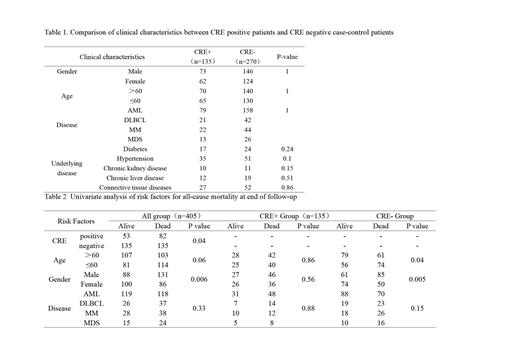Patients with hematologic diseases are often accompanied by immunodeficiency, treatments as well as the disease itself can lead to granulocyte deficiency. Patients with granulocyte deficiency are under the high risk of infection. In recent years, the rate of Carbapenem-resistant Enterobacteriaceae (CRE) infection has gradually increased. Treatment options of CRE infection is limited, and effective anti-infection treatment is usually delayed, leading to the death of patients due to infection. CRE screening can provide clinical evidence for early detection of CRE by clinicians, thereby formulating antimicrobial treatment strategies. However, whether the initial empirical treatment covering CRE can improve the adverse outcomes of patients still lacks a definitive conclusion.
We collected clinical data on patients with neutropenia who also undergoing CRE screening between January 2017 and December 2022. To further analyze the impact of CRE positivity on patient mortality risk and the clinical effectiveness of initial empirical treatment for CRE, we conducted two case-cohort studies with clinical baseline data matching.
In total, we performed 3529 fecal CRE screenings from 664 patients. Out of these, 345 screenings from 135 patients tested positive for CRE. We identified 16 different strains, with the most common being Klebsiella pneumoniae (184/345), followed by Escherichia coli (76/345). To determine the influence of CRE positivity on patient mortality rates, we conducted a 1:2 case matching based on age, gender, diagnosis, and medical history of CRE-positive patients (Table 1). The results showed that in the overall analysis, CRE positivity, age over 60, and male gender were adverse factors influencing mortality. However, in the subgroup analysis of CRE-positive patients, no adverse factors affecting mortality were observed.
To further assess the impact of CRE positivity on patient infection outcomes, we defined the initial antibiotic treatment strategies for a total of 4,872 infection events in screened patients. We divided them into the following groups: the empirical treatment group without CRE results (n=3,954), the empirical treatment group not covering CRE (n=122), and the CRE based empirical treatment group (n=796). The CRE based empirical treatment group had a higher success rate in initial empirical treatment compared to the group without covering CRE (65.5% vs. 59.0%).
To further investigate the differences in initial empirical treatment success rates and 30-day mortality rates between patients in the CRE-based empirical treatment group and empirical treatment group without CRE covering, we performed 1:2 case matching for clinical baseline data on age, sex, diagnosis, past history, and disease status at infection according to the clinical characteristics of the CRE-based anti-infection treatment group. The results indicated that there were no significant differences in initial empirical treatment success rate and 30-day mortality rate between the CRE-based empirical treatment group and case-matched controls.
In conclusion, diagnosing and treating patients with CRE infection presents significant challenges. Early screening for CRE and empirical treatment targeting CRE can increase the success rate of initial empirical treatment in CRE-positive patients.
Disclosures
No relevant conflicts of interest to declare.


This feature is available to Subscribers Only
Sign In or Create an Account Close Modal